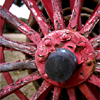
1. Cigars got their nickname of "stogies" from the Conestoga wagon wagons who smoked cigars or "stogies" as they drove the trail.
2. Most wagons on the Oregon Trail were NOT Conestoga wagons. These were slow, heavy freight wagons. Most Oregon Trail pioneers used farm wagons.
3. The pioneer, Ezra Meeker, became the "Champion of the Oregon Trail" when in 1906, at the age of 76, accompanied by two oxen, a driver and a dog, he made his way from his front yard in Puyallup, Washington to Washington, DC. His purpose was to preserve and re-mark the Oregon Trail, which was being obliterated by civilization. This man lived to age 98, and made the journey by ox team once more, then by automobile in 1915, and by airplane in 1924!
4. Most pioneers traveled the trails west by oxen. However, the Gold Rush of 1849 depleted the supply of oxen in the departure areas along the Missouri River, so gold seekers had to use more horses in 1850.
5. "Buffalo chips" were also called "meadow muffins". Some Indians called the Prairie Schooners, "horsecanoes" or "winged canoes". Indians called the Oregon Trail "the Great Medicine Road."
6. The old movies about the Oregon Trail are often inaccurate. Sometimes they show the pioneers using Conestoga wagons pulled by horses, with the pioneers riding. Actually, Conestoga wagons were too big and heavy for the Oregon Trail. Converted farm wagons, called Prairie Schooners, were actually used and pulled generally not by horses, but by oxen. In fact, oxen were led. There were no reins. Plus, the Prairie Schooner wagons often had no seat and the pioneers generally walked along the Trail. The ride was too bumpy!
7. Many people think the famous Oregon Trail landmark, Independence Rock, was named by the early emigrants who arrived here on Independence Day! Actually, it was named years earlier by fur traders. In fact, in order to beat the bad snows and weather of fall and winter, emigrants needed to be past Independence Rock by the Fourth of July at South Pass if they were to be on a good, safe schedule!
8. From 1840 to 1860, the total number of people who traveled the Oregon, California, and Mormon Trails is estimated to be between 315,000 and 320,000. The entire population of the United States during this period went from just over 17 million in 1840 to about 31 million in 1860.
9. Most of the emigrants on the Oregon Trail survived the trip. Between four and six percent of the emigrants died along the way - between 12,500 and 20,000 people. This is about one grave for every 200 yards of trail (the length of two football fields). Most of those who died were either children or elderly people.
10. The four most common causes of death on the Trail were cholera, wagon accidents, drownings during river crossings, and accidental gunshots- not Indian attacks! In the period 1840 - 1860, fewer than 350 emigrants were killed by Native Americans.
11. Most people think that those who headed west in wagon trains were poor, impoverished people desperate for a "second chance." They were mostly middle class, successful people, aiming to become more successful in the west! It took from one to three years' wages JUST to buy the supplies needed for the journey.
12. Wagon trains traveled in single-file "lines" - right? WRONG! Whenever possible, the pioneers spread out their wagons across in order to avoid choking on each other's dust. It was only through narrow passages where they had no other choice that the wagons traveled single file.
13. Why did the wagon trains form a circle overnight or during rest periods? Was it for protection from Indian attacks? NO! It was simply to make a corral for their animals, making them less likely to stray away.
14. Did you know that the pioneers ate a lot of pickles on the Oregon Trail? Although the pioneers didn't know the scientific reason for it, the they knew that eating fresh fruits and vegetables would keep them safe from the deficiency disease, scurvy. Because fresh fruits and vegetables were hard to come by over much of the trail, pioneers would bring a lot of pickles along, which also were an excellent source of Vitamin C.